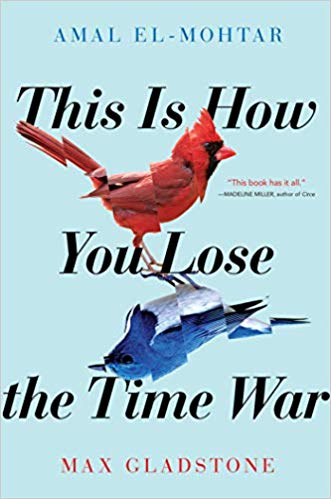 This Is How You Lose the Time War by Amal El-Mohtar, Max Gladstone
This Is How You Lose the Time War by Amal El-Mohtar, Max Gladstone Format: eARC
Source: supplied by publisher via NetGalley
Formats available: hardcover, paperback, ebook, audiobook
Genres: science fiction, time travel
Pages: 201
Published by Saga Press on July 16, 2019
Purchasing Info: Author's Website, Publisher's Website, Amazon, Barnes & Noble, Kobo, Bookshop.org
Goodreads
Two time-traveling agents from warring futures, working their way through the past, begin to exchange letters—and fall in love in this thrilling and romantic book from award-winning authors Amal-El Mohtar and Max Gladstone.
Among the ashes of a dying world, an agent of the Commandant finds a letter. It reads: Burn before reading.
Thus begins an unlikely correspondence between two rival agents hellbent on securing the best possible future for their warring factions. Now, what began as a taunt, a battlefield boast, grows into something more. Something epic. Something romantic. Something that could change the past and the future.
Except the discovery of their bond would mean death for each of them. There’s still a war going on, after all. And someone has to win that war. That’s how war works. Right?
Cowritten by two beloved and award-winning sci-fi writers, This Is How You Lose the Time War is an epic love story spanning time and space.
My Review:
If Kage Baker’s Novels of the Company and Good Omens had a book baby, it would be This Is How You Lose the Time War. Including the implied queer romance between Aziraphale and Crowley being realized and not merely implied. Just completely gender-swapped. At least, in as much as Red and Blue have gender as we understand it.
Howsomever, while I loved Kage Baker’s series, especially the first dozen books or so – start with In the Garden of Iden and be prepared to disappear for a few weeks – and Good Omens the book was even better than the TV series, which was awesome in its own way, I’m not sure I actually liked This Is How You Lose the Time War.
It’s fascinating in some ways. And it’s a quick read. But “like” is much too pale and wishy-washy a word. I feel like I’m sitting on a fence with this book, in the sense that all that sitting on a fence usually gets you is splinters up your arse.
Let me attempt an explanation.
What Time War has in common with The Company is the concept of two factions seeding themselves through time, both attempting to control the outcome of history for their own ends. And both having agents in place – or rather in time – in various successful and unsuccessful efforts to change history.
And the concepts of “good” and “evil” in both series end up being far from clear cut. From our limited 21st century perspective it is impossible to know whether history would “better” – for very undefined meanings of “good”, “evil” and “better”, whether Red’s mecha-cyber future is superior to Blue’s “Garden”.
But, even though Time War eschews any concepts of absolute good or absolute evil, even in the watered down and corrupted versions of both that are exposed in Good Omens, what this book does borrow from Gaiman and Pratchett is, in part, the same thing that they borrowed from Cold War era spy fiction – that sometimes, in the midst of a long, long war, the agents from the opposing forces have more in common with each other than either does with their respective home teams.
They have both “been in the long grass and seen the elephant” in ways that no one can understand – unless they been in there with them in a way that only their opposite number has done.
At the same time, the friendly-but-opposing protagonists of This is How You Lose the Time War do come to the same conclusion that Aziraphale and Crowley do – that they are together on their own side, and if need be, alone against the cosmos.
Escape Rating B-: I am still not sure how I feel about this book. I’m baffled and a bit confused.
There’s a part that is fascinated by how the story is told. It doesn’t begin and the beginning, tell a story, and end at the end. Instead, the story is told through a series of letters written between Red and Blue. It’s not just the letter itself, but also the circumstances surrounding the discovery of each letter.
We get bits and pieces of who these two are, what they are, and the neverending war that they were born to fight. We’re also supposed to see them fall in love with each other through their correspondence, but I’m not sure I see how it happens. I mean, I see that it does, but without them ever meeting face to face, I’m not quite sure I buy the romance.
I’m equally fascinated by the way that the story ends, because it doesn’t. It comes full circle and then kind of fades to black. We’re left hoping that they found a way, but we don’t see it.
In the end, I found This is How You Lose the Time War to be more interesting than it was satisfying. A lot of people seem to have absolutely adored it. I think I wanted more plot to sink my teeth into.
Your mileage, as always, may vary.
